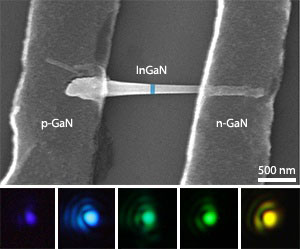| Oct 11, 2011 |
A rainbow of LED colors using a single semiconductor compound
|
|
(Nanowerk News) Light-emitting diodes (LEDs) of various colors are ubiquitous in daily life. As the color or wavelength of light emitted by the LED is determined by the semiconductor used in its construction, however, it has proved difficult to construct broad-spectrum LEDs with structures simple enough for industrial production. Shangjr Gwo and colleagues from National Tsing-Hua University in Taiwan have now developed a nanorod-based LED that can produce light across the entire visible spectrum using a single semiconductor ("Single InGaN nanodisk light emitting diodes as full-color subwavelength light sources").
|
 |
| A scanning electron microscopy image of the GaN/InGaN nanorods (upper) and examples of the light produced by nanorod LEDs. (© 2011 AIP)
|
|
The emission wavelength of an LED is determined by the energy gap in the electronic states of the emitting semiconductor. Tuning the color of an LED means altering this fundamental energy gap, which can be achieved by adjusting the composition of the semiconductor. Unfortunately, there are limits as to how much the composition can be altered before the material becomes unstable, and even with the most sophisticated semiconductor alloy films, researchers have been unable to produce all visible colors with adequate efficiency.
|
|
On the nanoscale, however, a larger variation in stable compositions is possible. A semiconductor alloy made from indium gallium nitride (InGaN), for example, can be tuned continuously across the entire visible spectrum in nanoscale structures simply by adjusting the ratio of indium to gallium. Gwo and his colleagues constructed their broad-spectrum device by arraying a series of chemically 'doped' GaN nanorods with a central nanodisk of InGaN (see image). The conversion of electrical charge into light in the nanorods is confined to the InGaN disk, substantially increasing emission efficiency. Using this architecture, the researchers were able to fabricate a number of LEDs with different emission characteristics using the same semiconductor system.
|
|
Not only does the nanorod LED provide broad tunability in a single-semiconductor system, the rods are also small enough to focus light onto smaller spots than can be achieved using a microscope. This means the nanorod LEDs could have applications in photolithography, such as in the fabrication of computer chips. "Our nanorod system with its tunable electronic structure also holds great promise for applications in solid-state lighting and photovoltaics," explains Gwo, "and in the future could find uses in ultrahigh-density data storage, subdiffraction-limited nanolithography, single-molecule sensing and even integrated optics."
|

